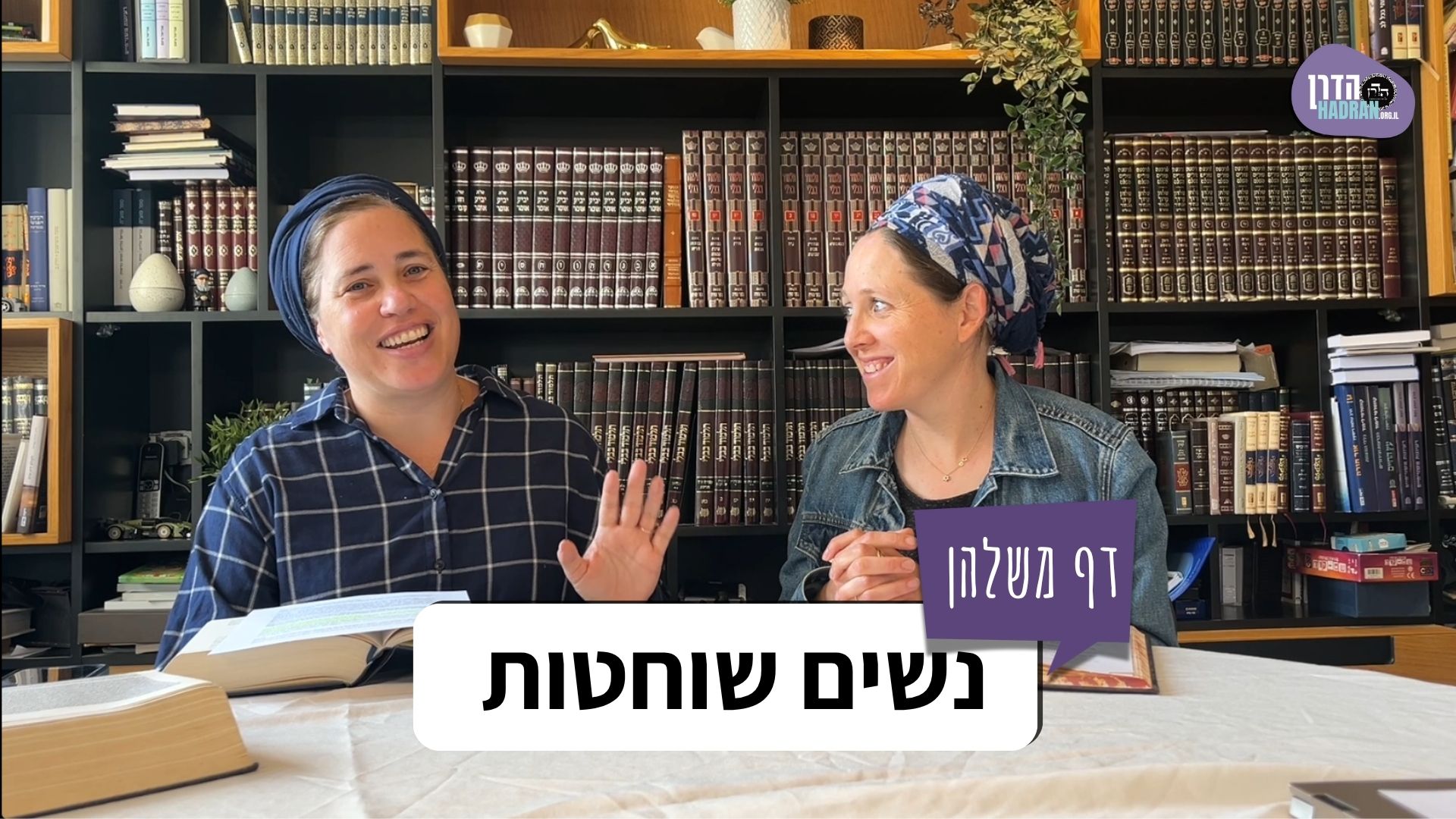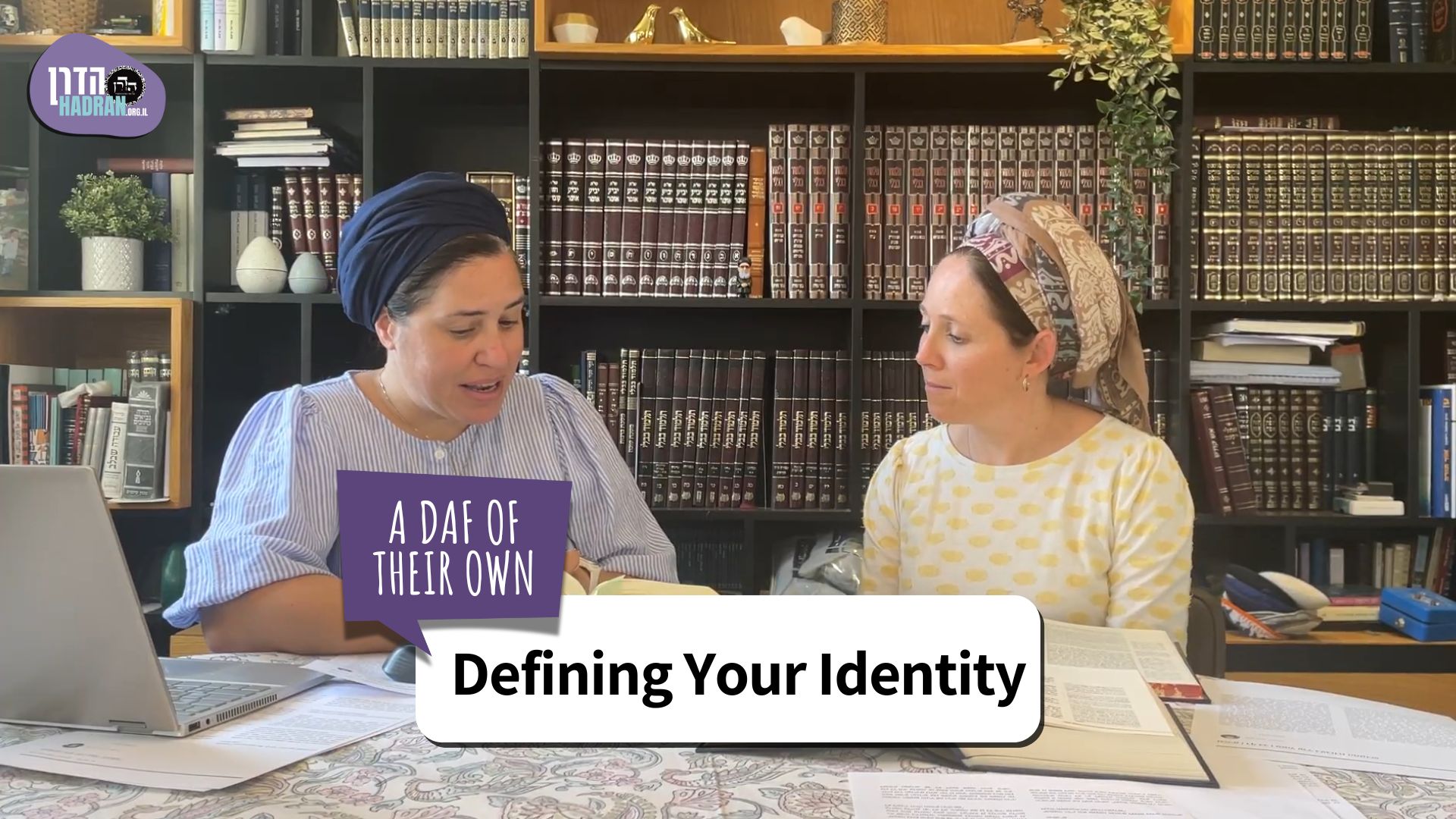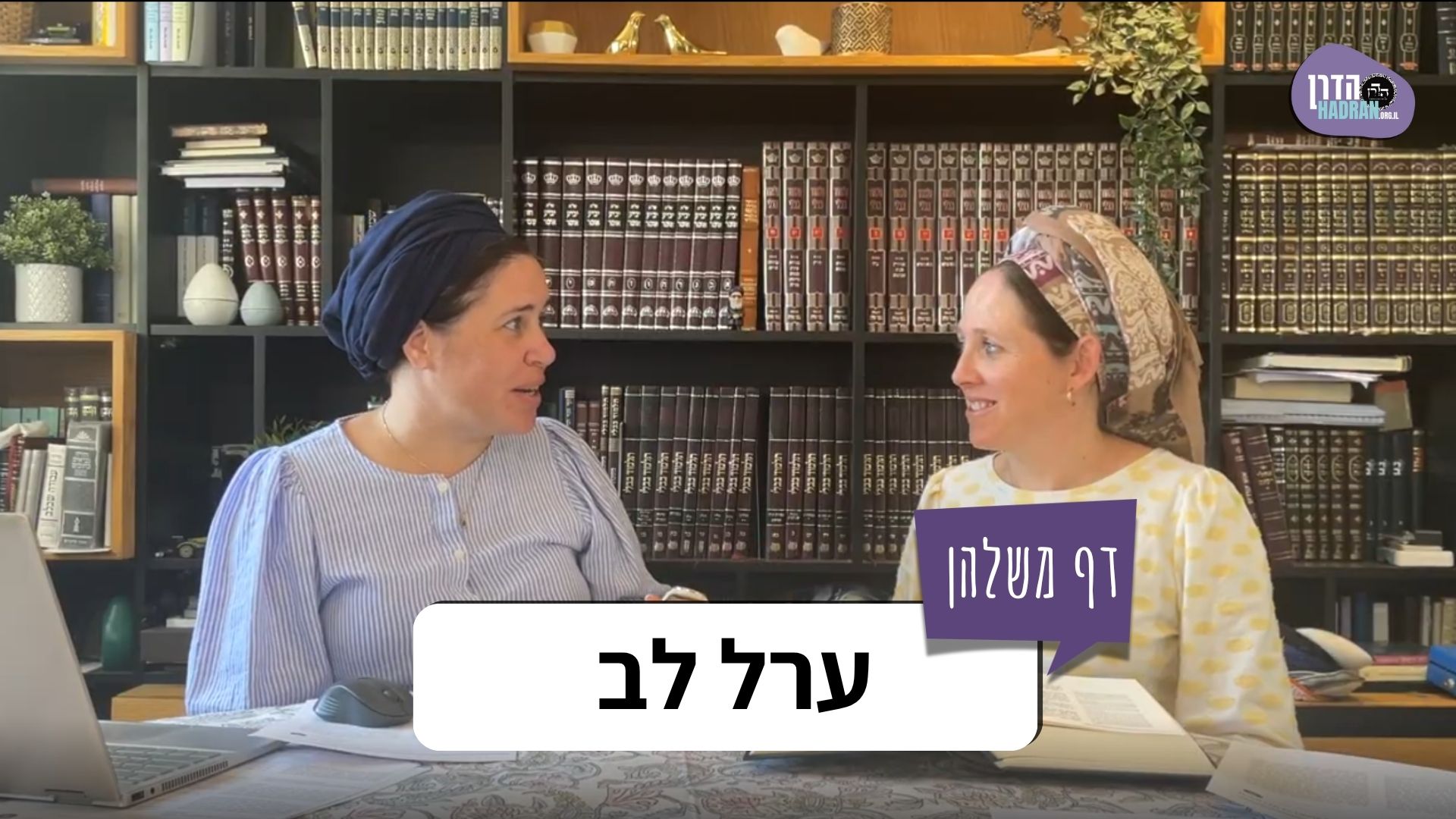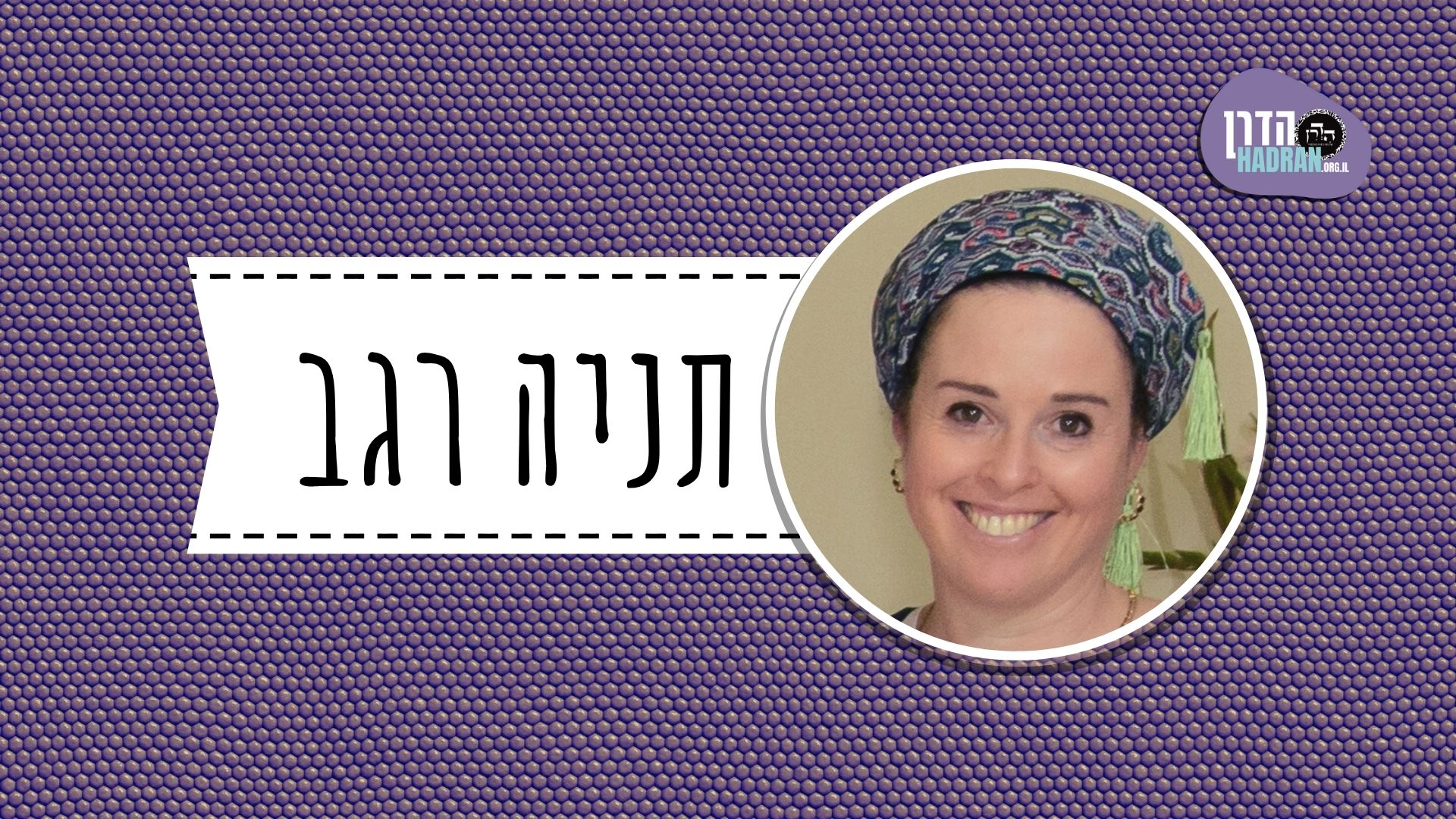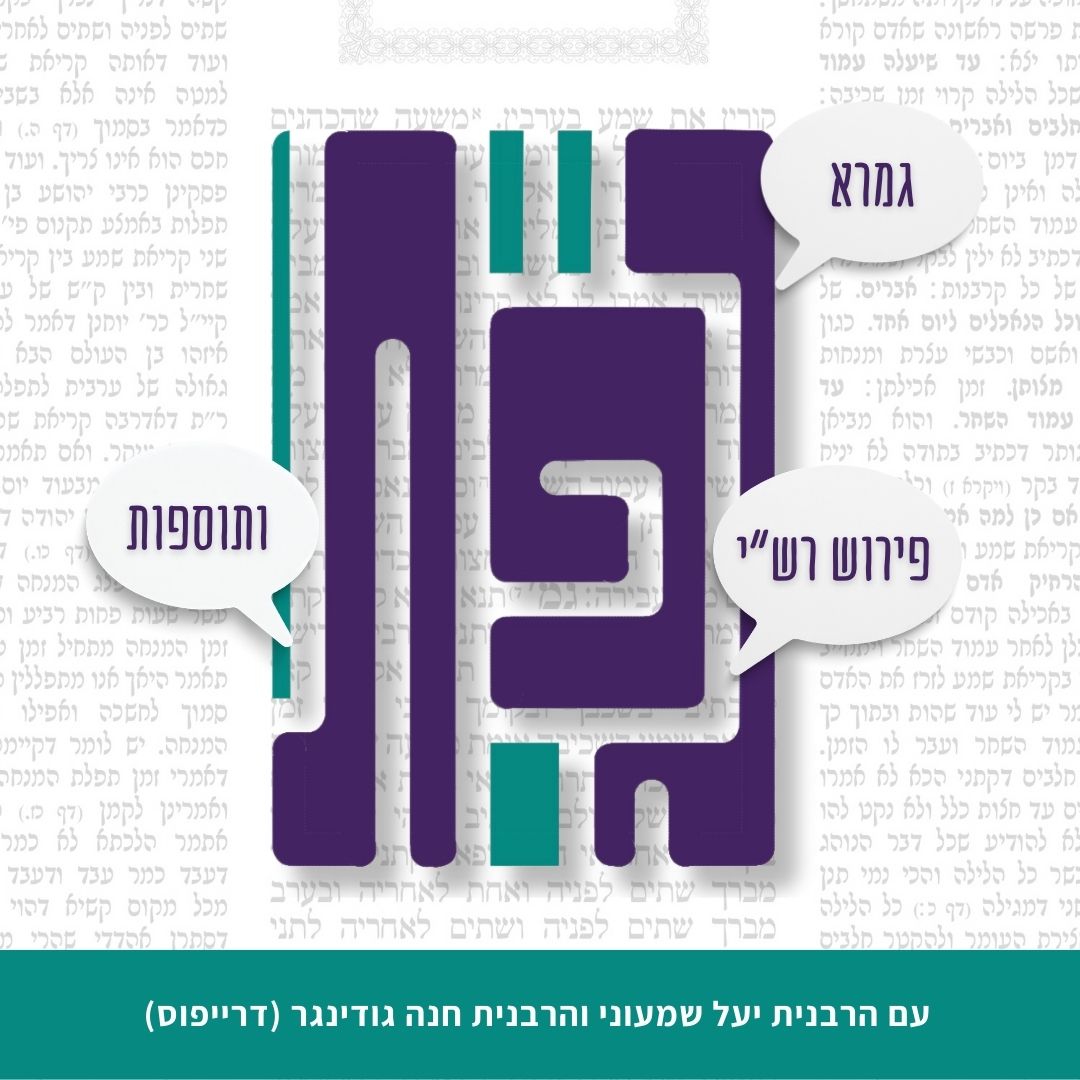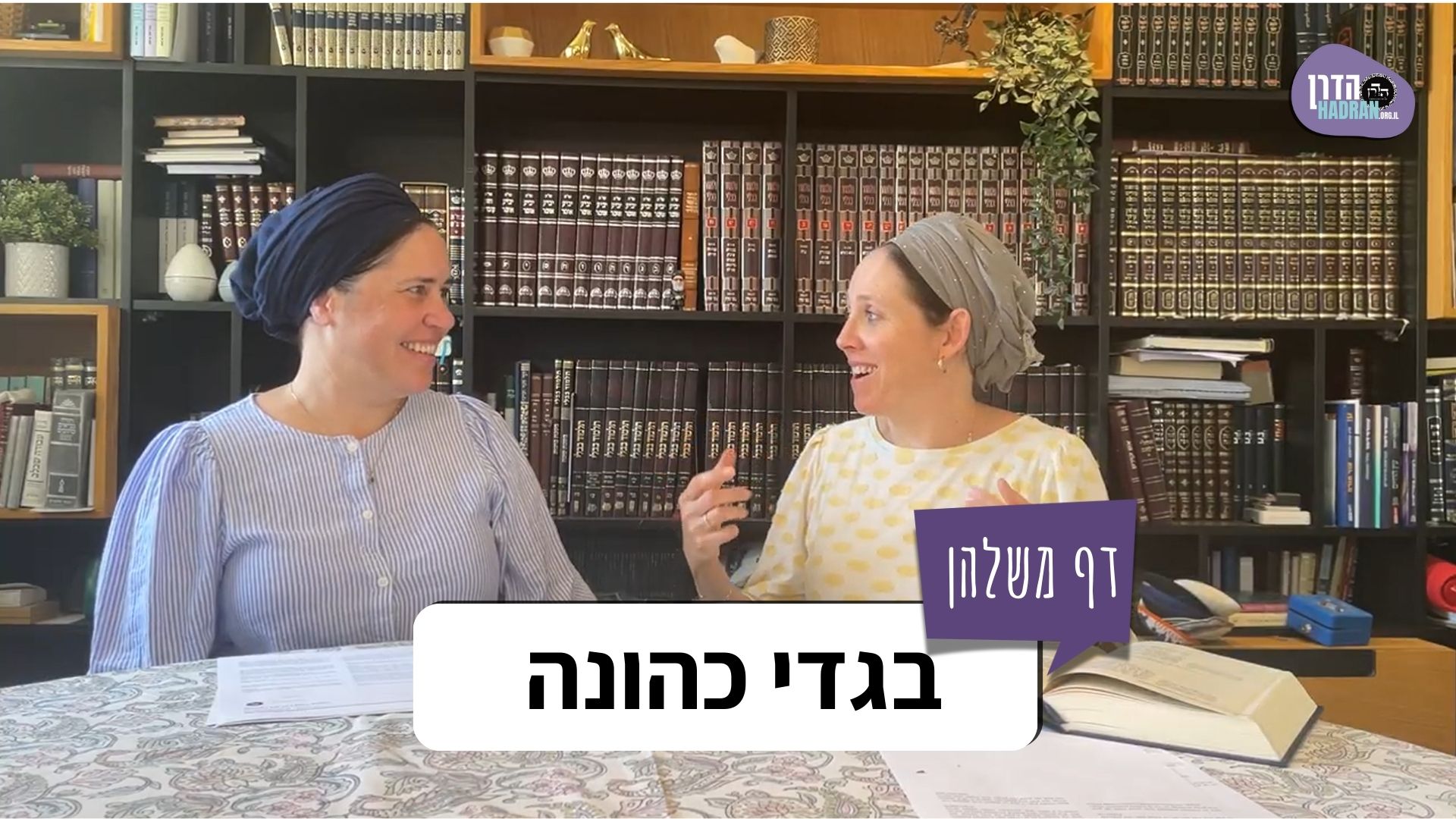When it is considered birth (in a stillborn animal) for purposes of determining was this a birth of a firstborn to exempt the next offspring from being a firstborn, particularly in a case of a difficult birth where the animal is taken out in parts? Is there impurity of a dead animal for fetuses for non-kosher animals? For kosher animals?
This month’s learning is sponsored by Beth Balkany in honor of their granddaughter, Devorah Chana Serach Eichel. “May she grow up to be a lifelong learner.”
Want to dedicate learning? Get started here:


This month’s learning is sponsored by Beth Balkany in honor of their granddaughter, Devorah Chana Serach Eichel. “May she grow up to be a lifelong learner.”
Delve Deeper
Broaden your understanding of the topics on this daf with classes and podcasts from top women Talmud scholars.
New to Talmud?
Check out our resources designed to help you navigate a page of Talmud – and study at the pace, level and style that fits you.
The Hadran Women’s Tapestry
Meet the diverse women learning Gemara at Hadran and hear their stories.
Chullin 70
ואי אתמר בהא בהא קאמר רבה אבל בהא אימא מודי ליה לרב הונא צריכא
And if their dispute was stated only with regard to that case, when one-third emerged through the wall of the womb, one might have thought it is only in that case that Rabba says the animal is consecrated from that point forward, as that results in a stringency, i.e., the fetus is subject to firstborn status. But in this case, when after one-third emerged it was sold to a gentile, and where ruling that the animal is consecrated from that point forward results in a leniency, one might say that Rabba concedes to Rav Huna. Therefore, it was necessary for the dispute to be stated in both cases.
תנן המבכרת המקשה לילד מחתך אבר אבר ומשליך לכלבים מאי לאו מחתך ומניח ואי אמרת למפרע הוא קדוש יקבר מיבעי ליה
The Gemara raises a difficulty with the opinion of Rav Huna. We learned in the mishna: If an animal that was giving birth to a firstborn male was encountering difficulty giving birth, and in order to alleviate the difficulty one wishes to terminate the birth, he may cut up the fetus limb by limb and cast it to the dogs. What, is it not teaching that one cuts each limb and leaves it outside the body, casting the limbs to the dogs only after he has already extracted a majority of its body? And if you say a firstborn is consecrated retroactively, then once the majority of the fetus emerges from the womb all of the limbs would be consecrated retroactively according to Rav Huna. Accordingly, the mishna should have said the limbs must be buried.
לא הכא במאי עסקינן במחתך ומשליך
The Gemara responds: No, here we are dealing with one who cuts each limb and immediately casts it to the dogs, before any consecration takes effect.
אבל מחתך ומניח מאי יקבר אדתנא סיפא יצא רובו יקבר ונפטרה מן הבכורה ליפלוג וליתני בדידיה במה דברים אמורים במחתך ומשליך אבר אבר אבל מחתך ומניח יקבר
The Gemara asks: But according to this, if one cuts the limbs and leaves them, what is the halakha? Each one must be buried. If that is so, rather than teaching in the latter clause of the mishna: If a majority of the fetus had already emerged it is considered to have been born and duly consecrated, and so if one cut it up it must be buried, and any future offspring from that animal is exempted from firstborn status; let the tanna instead distinguish and teach a case in which the limbs are consecrated within the context of the first case itself, in the following manner: In what case is this statement, that the limbs may be cast to the dogs, said? It is with regard to one who cuts pieces of the fetus and immediately casts them to the dogs limb by limb, before a majority has emerged. But if one cuts and leaves the limbs until a majority has emerged, each one of them must be buried.
הכי נמי קאמר בד”א במחתך ומשליך אבל מחתך ומניח נעשה כמי שיצא רובו ויקבר
The Gemara answers: That is indeed what the latter clause of the mishna is saying: In what case is this statement said? It is with regard to one who cuts and casts the limbs to the dogs before a majority emerges. But if one cuts and leaves the limbs until a majority emerges it is regarded as though a majority of it emerged at one time, and so it must be buried.
בעי רבא הלכו באיברין אחר הרוב או לא הלכו באיברין אחר הרוב היכי דמי
§ Rava raises a dilemma: Does one follow the majority with regard to limbs or does one not follow the majority with regard to limbs? The Gemara asks: What are the circumstances of this dilemma; what exactly is Rava’s question?
אילימא כגון שיצא רוב במיעוט אבר וקא מיבעיא ליה האי מיעוט דבראי בתר רוב דאבר שדינן ליה או בתר רובא דעובר שדינן ליה
If we say it is referring to a case where the majority of the fetus emerged, but that majority includes the emergence of the minority part of one of its limbs, then Rava is raising the following dilemma: With regard to this minority part of a limb that is outside the womb, do we cast it, i.e., count it, together with the majority of that limb, which is still inside the womb, as if the entire limb was still inside the womb? If so, it would be regarded as though a majority of the fetus has not yet emerged. Or perhaps we cast it and count it together with the majority of the fetus that has already emerged, and so it is regarded as though a majority of the fetus has emerged and it is duly consecrated.
פשיטא דלא שבקינן רובא דעובר ואזלינן בתר רוב אבר
The Gemara rejects this possibility: In that case it is obvious that we do not disregard the majority of the fetus and go after the majority of the limb. Consequently, Rava would not have raised a dilemma about this.
אלא כגון שיצא חציו ברוב אבר וקא מיבעיא ליה ההוא מיעוט דבגואי מהו למישדייה בתר רוב אבר
Rather, the dilemma is referring to a case where half of the fetus emerged, but that half includes the majority of a certain limb, and Rava raises the following dilemma: With regard to this minority part of a limb that is inside the womb, what is the halakha as to whether one casts it and counts it together with the majority of that limb and considers it as if that entire limb has emerged? If it is counted, it would be regarded as though a majority of the fetus has emerged, and it is duly consecrated.
ת”ש יצא רובו הרי זה יקבר מאי רובו אילימא רובו ממש עד השתא לא אשמעינן דרובו ככולו
The Gemara suggests: Come and hear a resolution from a statement of the mishna: If a majority of the fetus had already emerged, it is considered to have been born and duly consecrated, and so if one cut it up it must be buried. The Gemara clarifies: What is meant by a majority of the fetus? If we say it means literally the majority of the fetus, then the following difficulty arises: Until now had we not learned the principle that the majority of an item is considered like all of it? This is a well-established principle and it is not necessary to teach it again in this context.
אלא לאו כגון שיצא חציו ברוב אבר
Rather, is the mishna not referring to a case where half of the fetus emerged, but that half includes the majority of a limb? If so, the mishna directly resolves Rava’s dilemma and teaches that the minority part of the limb inside the womb is regarded as though it had emerged.
לא כגון שיצא רובו במיעוט אבר וקמ”ל דלא שבקינן רובו דעובר דבהמה ואזלינן בתר אבר
The Gemara responds: No, the mishna could be referring to a case where the majority of the fetus emerged, but that majority includes the emergence of the minority of a limb, and it teaches us that we do not disregard the majority of the fetus and go after the majority of the limb.
בעי רבא כרכו בסיב מהו בטליתו מהו
§ A firstborn animal is consecrated by virtue of the fact that its birth is the first in which the womb of the mother opens, as indicated by the verse: “Consecrate to Me every firstborn, that which opens the womb” (Exodus 13:2). Concerning this condition, Rava raises a dilemma: If one wrapped the fetus in the bast of a palm tree while it was still in the womb, and it therefore did not come in contact with the opening of the womb directly when it emerged, what is the halakha with regard to whether it is consecrated? Likewise, if one wrapped it in his robe when it emerged, what is the halakha?
בשליתו מהו בשליתו אורחיה הוא אלא בשליא אחרת מהו
Rava adds: If it emerged wrapped in its afterbirth, what is the halakha? The Gemara interjects: How could one suggest that being wrapped in its afterbirth would pose a problem? That is its natural manner of birth, and the afterbirth is consequently not considered an interposition. Accordingly, it is considered as though it was in direct contact with the opening of the womb. Rather, Rava’s dilemma must be as follows: If it emerged wrapped in the afterbirth of a different animal, what is the halakha?
כרכתו ואחזתו והוציאתו מהו היכי דמי אי דנפק דרך רישיה פטרתיה אלא דנפק דרך מרגלותיו
Another dilemma: If one wrapped it in one’s hands and held it and brought it out in that fashion, such that the fetus did not come in direct contact with the opening of the womb, what is the halakha? With regard to all these dilemmas the Gemara asks: What are the circumstances? If the fetus had already partially emerged headfirst and then one wrapped up the body, which was still inside the womb, the halakha in such a case is clear: Since its head emerged, it is already considered to have been born and to have opened up the womb, and it is duly consecrated. Rather, the dilemma is in a case where it partially emerged hind legs first, and the majority of the body, which was still in the womb, was wrapped before it emerged.
בלעתהו חולדה והוציאתו מהו הוציאתו הא אפיקתיה אלא בלעתו והוציאתו והכניסתו והקיאתו ויצא מאליו מהו
Rava raises additional dilemmas: If a weasel entered the womb and swallowed the fetus there, and then exited the womb, bringing the fetus out in its stomach, what is the halakha? The Gemara interjects: Is there any doubt about a case where the weasel brought the fetus out in its stomach? In such a case it is the weasel that brought it out, and it is certainly not regarded as though the fetus opened the womb. Rather, the dilemma concerns a case where the weasel swallowed the fetus and brought it out, and then brought it back into the womb and vomited it out while inside the womb, and the fetus subsequently emerged of its own accord. What is the halakha in this case?
הדביק שני רחמים ויצא מזה ונכנס לזה מהו דידיה פטר דלאו דידיה לא פטר או דלמא דלאו דידיה נמי פטר תיקו
Another dilemma: If one pressed together the openings of two wombs of two animals giving birth to firstborns, and a fetus exited from the womb of this animal and entered the womb of that animal, and then emerged from the womb of the second animal, after which the second animal gave birth to its fetus, what is the halakha with regard to whether the fetus of the second animal is consecrated as a firstborn? Is the womb considered to have opened only when its own fetus emerges from inside, but a fetus that is not its own is not halakhically considered to have opened the womb? Or perhaps even a fetus that is not its own is also considered to have opened the womb? The Gemara does not provide a resolution for these dilemmas and concludes: The dilemma shall stand unresolved.
בעי רב אחא נפתחו כותלי בית הרחם מהו אויר רחם מקדיש והאיכא או דלמא נגיעת רחם מקדשה והא ליכא
Rav Aḥa raises a dilemma: If the walls of the opening of the womb opened and widened to such an extent that when the fetus emerged it did not touch them, what is the halakha? Does the airspace of the opening of the womb consecrate the fetus as it is born, and this situation exists here in this case; or perhaps it is the contact with the opening of the womb that consecrates it, and this situation does not exist here in this case?
בעי מר בר רב אשי נעקרו כותלי בית הרחם מהו נעקרו ליתנהו אלא נעקרו ותלו ליה בצואריה מאי במקומן מקדשי שלא במקומן לא מקדשי או דלמא שלא במקומן נמי מקדשי
Mar bar Rav Ashi raises a dilemma: If the walls of the opening of the womb were removed, what is the halakha? The Gemara interjects: The halakha in this case is clear, since if they were removed they are not there to consecrate the fetus. Rather, the dilemma is in a case where they were removed from their original place, recessed inside the womb, and as the fetus emerged, the walls lay on its neck. In such a case, what is the halakha? Do the walls of the opening of the womb consecrate a fetus only when they are in their natural place, but when they are not in their natural place they cannot consecrate a fetus? Or perhaps when they are not in their natural place they also consecrate the fetus.
בעי מיניה ר’ ירמיה מר’ זירא נגממו כותלי בית הרחם מהו א”ל קא נגעת בבעיא דאיבעיא לן דבעי ר’ זירא ואמרי לה בעא מיניה ר’ זירא מרבי אסי עומד מרובה על הפרוץ ויצא דרך פרוץ פרוץ מרובה על העומד ויצא דרך עומד מאי
Rabbi Yirmeya raises a dilemma before Rabbi Zeira: If the walls of the opening of the womb were thinned [nigmemu] by removing the inner layer, what is the halakha? If the fetus then emerges through them is it consecrated? Rabbi Zeira said to him: You have touched upon a dilemma that was already raised before us, and that discussion provides the answer to your dilemma. As Rabbi Zeira raised a dilemma, and some say Rabbi Zeira raised that dilemma before Rabbi Asi: If a section of the opening of the womb was cut away, but the standing section, i.e., the part remaining, is greater in size than the breached, removed, section, and the offspring emerged through the breached section; or if the breached section is greater in size than the standing section and the offspring emerged through the standing section, what is the halakha?
עד כאן לא איבעיא ליה אלא פרוץ מרובה על העומד דאיכא עומד בעולם אבל נגממו לא קא מיבעיא ליה:
Rabbi Zeira explains how this dilemma can resolve Rabbi Yirmeya’s dilemma: That dilemma was raised only with regard to a case where the breached section is greater than the standing section, as there is at least some part of the womb still standing and therefore one can consider the possibility that it could consecrate the fetus. But a dilemma was not raised with regard to case where the walls were thinned, because in that case it is obvious that the fetus is not consecrated, as there is nothing left to consecrate it.
מתני׳ בהמה שמת עוברה בתוך מעיה והושיט הרועה את ידו ונגע בו בין בבהמה טמאה בין בבהמה טהורה טהור ר’ יוסי הגלילי אומר בטמאה טמא ובטהורה טהור:
MISHNA: With regard to an animal whose fetus died in its womb and the shepherd reached his hand into the womb and touched the fetus, both in the case of a non-kosher animal and in the case of a kosher animal the fetus does not have the status of an animal carcass that imparts ritual impurity, and the shepherd remains ritually pure. Rabbi Yosei HaGelili says: In the case of a non-kosher animal it is impure, and in the case of a kosher animal it is pure.
גמ׳ מאי טעמא דתנא קמא אמר רב חסדא קל וחומר אם הועילה אמו להתירו באכילה לא תועיל לו לטהוריה מידי נבלה
GEMARA: The Gemara asks: What is the reason for the ruling of the first tanna? Rav Ḥisda said: It is apparent through an a fortiori inference: If being inside its mother is effective to permit it for consumption through the slaughter of its mother even if the fetus was found dead inside the womb, then should being inside its mother not also be effective to render it pure from the impurity of an animal carcass?
אשכחן בהמה טהורה בהמה טמאה מנלן אמר קרא (ויקרא יא, לט) וכי ימות מן הבהמה זו בהמה טמאה אשר היא לכם לאכלה זו בהמה טהורה איתקש בהמה טמאה לבהמה טהורה מה בהמה טהורה עוברה טהור אף בהמה טמאה עוברה טהור
The Gemara asks: We found a rationale for this halakha with regard to a kosher animal; from where do we derive that the same applies to a non-kosher animal? The Gemara answers that the verse states: “And when a domesticated animal dies, of those that you eat, one who touches its carcass shall be impure until the evening” (Leviticus 11:39). The Gemara interprets the verse as follows: “And when a domesticated animal dies,” this is referring to a non-kosher animal; “of those that you eat,” this is referring to a kosher animal. The verse thereby juxtaposes a non-kosher animal to a kosher animal with regard to imparting impurity of a carcass, and teaches that just as with regard to a kosher animal, its fetus that died in its womb is pure, as derived above through an a fortiori inference, so too, with regard to a non-kosher animal, its dead fetus is pure.
ור’ יוסי הגלילי מאי טעמא אמר ר’ יצחק דאמר קרא (ויקרא יא, כז) וכל הולך על כפיו בכל החיה ההולכת וגו’ מהלכי כפים בחיה טמאתי לך
The Gemara asks: And as for Rabbi Yosei HaGelili, what is the reason for his ruling? Rabbi Yitzḥak said that the verse states with regard to non-kosher animals that do not have cloven hooves: “And whatever walks on its paws, among any [bekhol] undomesticated animal [ḥayya] that walks on all fours, they are impure for you; whoever touches their carcass shall be impure until the evening” (Leviticus 11:27). Rabbi Yosei HaGelili expounds this verse as follows: Those animals that walk on their paws, i.e., that do not have cloven hooves, which are inside the body of an animal, I rendered impure for you. Rabbi Yitzḥak interprets the term bekhol as meaning: Inside the body of, and the word ḥayya as meaning: A live animal. Accordingly, he understands the verse to be referring to a dead fetus found inside a living animal.
אלא מעתה קלוט במעי פרה ליטמא דמהלכי כפים בחיה הוא מהלכי כפים במהלכי ארבע והאי מהלכי ארבע במהלכי שמנה הוא
The Gemara objects: If that is so, then a dead fetus with non-cloven hooves found inside a cow should be impure, despite the fact that it is from a kosher species, as it is an animal that walks on its paws that is inside the body of a kosher animal. The Gemara explains: The verse renders impure an animal that walks upon its four paws that is inside an animal that walks on four paws. But this is a case of an animal that walks on four inside an animal that walks on eight. Since the mother cow’s hooves are entirely split into two parts, it actually walks on eight parts and is not the animal referred to by the verse.
פרה במעי גמל לא תטמא דמהלכי שמנה במהלכי ארבע הוא הולך וכל הולך לרבות פרה במעי גמל
The Gemara raises another objection: If that is so, then a dead fetus in the form of a cow, which has eight parts to its legs, inside the womb of a camel, a non-kosher animal with non-cloven hooves, should not be impure, as it is an animal that walks on eight inside an animal that walks on four, and the verse is not referring to it. The Gemara responds that the verse could have stated: Walks upon, but instead states: “And whatever walks upon,” i.e., the addition of the word “whatever” serves to include a dead cow fetus in the womb of a camel, teaching that it is impure.
קלוט במעי קלוטה ליטמא דמהלכי ארבע במהלכי ארבע הוא להכי אהני ק”ו דרב חסדא
The Gemara objects: If that is so, then a dead fetus with non-cloven hooves inside the womb of a cow with non-cloven hooves should be impure, as it is an animal that walks on four inside an animal that walks on four, but the halakha is that since the mother is a kosher species, it is pure. The Gemara explains: It is to that end that the a fortiori inference of Rav Ḥisda is effective, as it renders pure the fetuses of all kosher animals, even if their hooves are not fully cloven.
מתקיף לה רב אחדבוי בר אמי חזיר במעי חזירתא לא ליטמא דמהלכי שמנה במהלכי שמנה הוא
Rav Aḥadvoi bar Ami objects to this explanation that the verse renders impure only animals that walk on four inside animals that walk on four: If that is so, a dead pig fetus inside the womb of a female pig should not be impure, as a pig has cloven hooves, and so it is an animal that walks on eight inside an animal that walks on eight, and so the verse is not referring to it.
אלא אמר רב נחמן בר יצחק מהכא (ויקרא ה, א) נפש כי תגע בכל טמא או בנבלת חיה טמאה או בנבלת בהמה טמאה או בנבלת שרץ טמא
Rather, Rav Naḥman bar Yitzḥak said that Rabbi Yosei HaGelili’s opinion is derived from here: The verse states with regard to the sliding-scale offering brought by one who was unaware that he was impure when he ate consecrated food or entered the Temple: “A person who touched anything impure, or the carcass of a non-kosher undomesticated animal, or the carcass of a non-kosher domesticated animal, or the carcass of an impure creeping animal, and is guilty, it having being hidden from him that he is impure” (Leviticus 5:2).
וכי נבלת בהמה טמאה מטמאה ובטהורה לא מטמאה אלא איזה זה זה עובר שבטמאה טמא ובטהורה טהור
The verse presents a difficulty: Does only a carcass of a non-kosher animal impart impurity, and that of a kosher animal not impart impurity? The halakha is that both do. Rather, what is this animal to which the verse is referring? This is a fetus, which if inside a non-kosher animal is impure, and if inside a kosher animal is pure.
ומאחר דנפקא ליה מדרב נחמן בר יצחק דרבי יצחק ל”ל אי לאו דר’ יצחק הוה אמינא כוליה לכדרבי הוא דאתא קמ”ל
The Gemara asks: And since this halakha is derived from the statement of Rav Naḥman bar Yitzḥak, why do I need the proof of Rabbi Yitzḥak from the verse: “And whatever walks on its paws, among any undomesticated animal that walks on all fours” (Leviticus 11:27)? The Gemara explains: Were it not for the derivation of Rabbi Yitzḥak, I would say that the entire verse expounded by Rav Naḥman bar Yitzḥak comes to teach only that which Rabbi Yehuda HaNasi derived from it, as cited by the Gemara later on. Rabbi Yitzḥak’s statement teaches us that the verse is also to be expounded as Rav Naḥman bar Yitzḥak explained.
תניא אמר ר’ יונתן נמתי לו לבן עזאי למדנו נבלת בהמה טהורה שמטמאה ונבלת בהמה טמאה שמטמאה נבלת חיה טמאה שמטמאה
§ It is taught in a baraita that Rabbi Yonatan, a student of Rabbi Yishmael, says: I said [namti] to ben Azzai: We learned that a carcass of a kosher domesticated animal imparts impurity from the verse: “And when a domesticated animal dies, of those that you eat, one who touches its carcass shall be impure until the evening” (Leviticus 11:39). And we learned that a carcass of a non-kosher domesticated animal imparts impurity, and that a carcass of a non-kosher undomesticated animal imparts impurity, from the verse: “A person who touched anything impure, or the carcass of a non-kosher undomesticated animal, or the carcass of a non-kosher domesticated animal” (Leviticus 5:2).
נבלת חיה טהורה לא למדנו מנין נם לי כל הולך על כפיו בכל החיה ההולכת
But we did not yet learn about a carcass of a kosher undomesticated animal. From where is it derived that it imparts impurity? Ben Azzai said to me that this is derived from the verse: “And whatever walks on its paws, among any undomesticated animal that walks on all fours” (Leviticus 11:27). The inclusive term “among any” serves to include even a carcass of a kosher undomesticated animal among those that impart impurity.
נמתי לו וכי נאמר וכל חיה והלא לא נאמר אלא בכל החיה למהלכי כפים בחיה הוא דאתא נם לי ומה ישמעאל אומר בדבר הזה
Rabbi Yonatan continues. I said to ben Azzai: But does it state: And any undomesticated animal? Isn’t it stated only: “Among any undomesticated animal”? And as explained earlier, this comes to teach that a dead fetus in the form of any of the animals that walk on their paws inside an undomesticated animal imparts impurity. He said to me: And what does Rabbi Yishmael, your teacher, say about this matter?
נמתי לו (ויקרא יא, לט) וכי ימות מן הבהמה זו בהמה טמאה אשר היא לכם לאכלה זו בהמה טהורה למדנו חיה בכלל בהמה ובהמה בכלל חיה
I said to him that Rabbi Yishmael derives all these halakhot from the verse: “And when a domesticated animal dies, of those that you eat, one who touches its carcass shall be impure until the evening” (Leviticus 11:39), as follows: “And when a domesticated animal [habehema] dies,” this is referring to a non-kosher animal; “of those that you eat,” this is referring to a kosher animal. And we learned that a ḥayya is included in the category of a behema, i.e., the term behema can also refer collectively to both domesticated and undomesticated animals. And likewise, a behema is included in the category of a ḥayya.
חיה טהורה בכלל בהמה טהורה חיה טמאה בכלל בהמה טמאה
Furthermore, a kosher ḥayya is included when the Torah makes reference to a kosher behema, and a non-kosher ḥayya is included when the Torah makes reference to a non-kosher behema.



